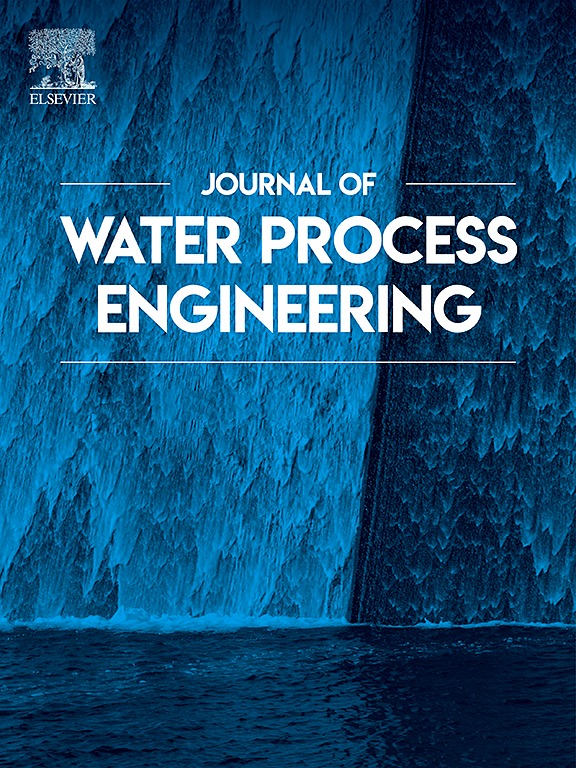Mn-doped copper slag with oxygen vacancies boosts peroxymonosulfate activation for ofloxacin rapid removal
IF 6.3
2区 工程技术
Q1 ENGINEERING, CHEMICAL
引用次数: 0
Abstract
This study developed a manganese-doped copper smelting slag (Mn@CSS) particle electrode to enhance peroxymonosulfate (PMS) activation for efficient ofloxacin (OFX) degradation. The Mn(II) doping strategy effectively modulated surface oxygen vacancies, with the optimal 0.08 doping ratio achieving doubled oxygen vacancy concentration compared to pristine CSS. Density functional theory (DFT) calculations revealed significantly enhanced PMS adsorption capacity, demonstrating a 57 % increase in adsorption energy (ΔEads = −3.31 eV for Mn@CSS vs. -2.10 eV for CSS). Notably, the O![]() O bond length extended from 1.45 Å to 1.74 Å upon adsorption, facilitating interfacial charge transfer. Under optimized conditions (pH 7.0, 1.50 g/L catalyst dosage, 20 mg/L initial OFX concentration, and 10 mA/cm2 current density), the system achieved exceptional performance with 99.90 % OFX removal and 58.79 % total organic carbon reduction within 30 min. Mechanistic investigations through electron paramagnetic resonance and LC-MS analyses identified synergistic contributions from multiple reactive species (SO₄•-, O₂•-, •OH, 1O₂, and Fe(IV)), driving mineralization via dealkylation, decarboxylation, and ring-opening pathways. The catalyst demonstrated remarkable stability with 87 % efficiency retention after five cycles and minimal metal leaching (Fe: 1.20 %, Mn: 0.79 %). This work not only provides a sustainable strategy for solid waste valorization but also elucidates the oxygen vacancy-mediated PMS activation mechanism through integrated experimental and theoretical approaches.
O bond length extended from 1.45 Å to 1.74 Å upon adsorption, facilitating interfacial charge transfer. Under optimized conditions (pH 7.0, 1.50 g/L catalyst dosage, 20 mg/L initial OFX concentration, and 10 mA/cm2 current density), the system achieved exceptional performance with 99.90 % OFX removal and 58.79 % total organic carbon reduction within 30 min. Mechanistic investigations through electron paramagnetic resonance and LC-MS analyses identified synergistic contributions from multiple reactive species (SO₄•-, O₂•-, •OH, 1O₂, and Fe(IV)), driving mineralization via dealkylation, decarboxylation, and ring-opening pathways. The catalyst demonstrated remarkable stability with 87 % efficiency retention after five cycles and minimal metal leaching (Fe: 1.20 %, Mn: 0.79 %). This work not only provides a sustainable strategy for solid waste valorization but also elucidates the oxygen vacancy-mediated PMS activation mechanism through integrated experimental and theoretical approaches.

含氧空位的掺锰铜渣促进过氧单硫酸盐活化,促进氧氟沙星的快速去除
本研究开发了一种掺杂锰的铜冶炼渣(Mn@CSS)颗粒电极,以增强过氧单硫酸盐(PMS)的活化,从而有效降解氧氟沙星(OFX)。Mn(II)掺杂策略有效地调节了表面氧空位,与原始CSS相比,最优掺杂比为0.08时,氧空位浓度增加了一倍。密度泛函理论(DFT)计算显示PMS的吸附能力显著增强,吸附能增加57% (Mn@CSS =−3.31 eV, CSS = -2.10 eV)。值得注意的是,吸附后OO键长度从1.45 Å延长到1.74 Å,有利于界面电荷转移。在优化条件下(pH 7.0,催化剂用量1.50 g/L,初始OFX浓度20 mg/L,电流密度10 mA/cm2),该体系在30分钟内取得了99.90%的OFX去除率和58.79%的总有机碳还原性能。通过电子顺磁共振和LC-MS分析,发现了多种反应物质(SO₄•-,O₂•-,O OH, O₂和Fe(IV))的协同作用,通过脱烷基作用驱动矿化。脱羧和开环途径。该催化剂表现出良好的稳定性,经过5次循环后,其效率保持率为87%,金属浸出率最低(Fe: 1.20%, Mn: 0.79%)。本研究不仅为固体废物增值提供了可持续的策略,而且通过实验和理论相结合的方法阐明了氧空位介导的PMS活化机制。
本文章由计算机程序翻译,如有差异,请以英文原文为准。
求助全文
约1分钟内获得全文
求助全文
来源期刊

Journal of water process engineering
Biochemistry, Genetics and Molecular Biology-Biotechnology
CiteScore
10.70
自引率
8.60%
发文量
846
审稿时长
24 days
期刊介绍:
The Journal of Water Process Engineering aims to publish refereed, high-quality research papers with significant novelty and impact in all areas of the engineering of water and wastewater processing . Papers on advanced and novel treatment processes and technologies are particularly welcome. The Journal considers papers in areas such as nanotechnology and biotechnology applications in water, novel oxidation and separation processes, membrane processes (except those for desalination) , catalytic processes for the removal of water contaminants, sustainable processes, water reuse and recycling, water use and wastewater minimization, integrated/hybrid technology, process modeling of water treatment and novel treatment processes. Submissions on the subject of adsorbents, including standard measurements of adsorption kinetics and equilibrium will only be considered if there is a genuine case for novelty and contribution, for example highly novel, sustainable adsorbents and their use: papers on activated carbon-type materials derived from natural matter, or surfactant-modified clays and related minerals, would not fulfil this criterion. The Journal particularly welcomes contributions involving environmentally, economically and socially sustainable technology for water treatment, including those which are energy-efficient, with minimal or no chemical consumption, and capable of water recycling and reuse that minimizes the direct disposal of wastewater to the aquatic environment. Papers that describe novel ideas for solving issues related to water quality and availability are also welcome, as are those that show the transfer of techniques from other disciplines. The Journal will consider papers dealing with processes for various water matrices including drinking water (except desalination), domestic, urban and industrial wastewaters, in addition to their residues. It is expected that the journal will be of particular relevance to chemical and process engineers working in the field. The Journal welcomes Full Text papers, Short Communications, State-of-the-Art Reviews and Letters to Editors and Case Studies
 求助内容:
求助内容: 应助结果提醒方式:
应助结果提醒方式:


